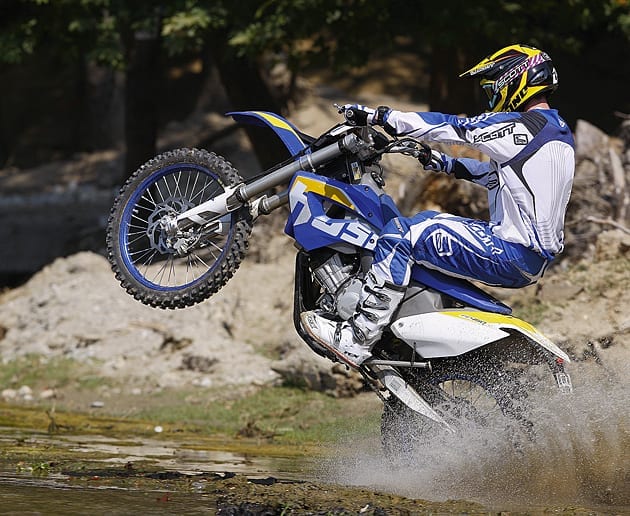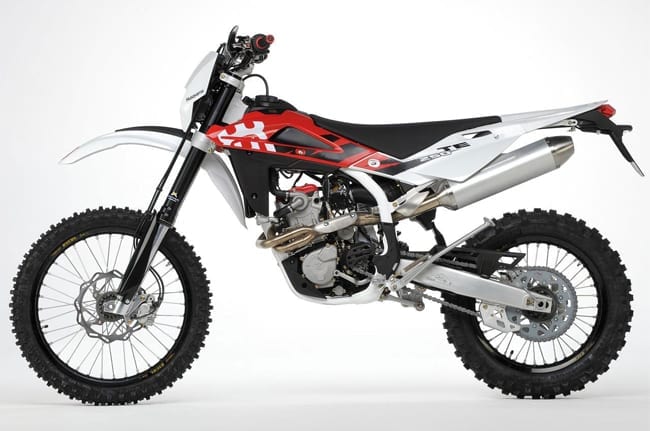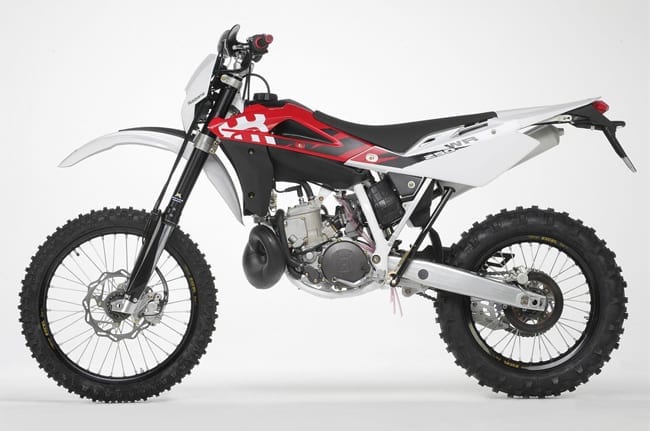Husaberg's different strokes
By TMX Archives on 11th Sep 08

NEW from the ground up and radically different to all other four-stroke enduro bikes, Husaberg's new FE 450 and FE 570 models are ready to challenge the way we think enduro bikes should be built...
WHEN Husaberg's first ever prototype enduro bike was unveiled to the world, back in 1988, the unconventional approach taken by the company's design team was clear for all to see. Featuring notable weight reductions, alternative frame construction, many never-before-seen design solutions, and for its day, a compact engine.
Husaberg was a fresh, young and ambitious new company born from the sale of Husqvarna to the Italians. In 1988 Husaberg wasn't afraid to do things differently.
But, as a small manufacturer, the Swedish concern struggled to build bikes that were as 'finished' as those offered by their competitors, despite numerous sporting successes and world wide acceptance of their products and philosophies.
With Yamaha then raising the bar for four-stroke design and manufacture to dizzying heights with the launch of the YZF400 in the late 1990s, Husaberg quickly became a quirky, northern European company seen by many as producing 'agricultural' thumpers.
Husaberg's 2009 FE 450 and FE 570 models are anything but old-school. New from the ground up, the two models offered by the now KTM-owned marque are both high-tech and contemporary. Featuring a radical departure from the dated machinery of recent years, the latest generation 'Bergs are ultra-modern in every way.
COMPACT
NEW, different and revised four-stroke motorcycle engine design is something we've all become used to seeing in recent years. As manufacturers try to claim the upper hand in the race to give us the 'latest and greatest', the design paths chosen by various companies have become increasingly varied.
Some engines are designed to deliver more power, some to deliver smoother power - Husaberg's new engines are designed to be compact, offer useable 'enduro friendly SOHC' power, while also significantly improving the bike's handling.
What Husaberg have set out to achieve by lifting the crank within their new motor before then wrapping it with a 100 per cent new chassis is deliver notably improved handling. And initial impressions are that this is exactly what it has achieved.
From the minute you sit on the new 'Berg you realise that it is a completely different and much more finished product to the one it replaces.
What you also realise is that the footpegs are a little higher than on many other bikes, that the motor has absolutely no clutch noise and that the bike is slim. The bike's ergonomics also feel notably sporty and the electric starter works well.
Once you start riding the new offerings two things become apparent - firstly, the SOHC motor is extremely smooth and, secondly, the Electronic Fuel Injection system (EFI) ensures that throttle response is instant. The action of the clutch and gearbox together makes changing gear effortless and the bike feels well balanced, comfortable and like it has had several years of development and not a product that is absolutely brand new.
It doesn't take long to realise that the SOHC engine configuration, that wants to constantly deliver smooth almost gentle power, and the EFI system, that wants to fire the bike into life instantly, work perfectly in combination together. Mixing mellow with instantaneous results in a smooth, strong power that has no hit, no snap, yet is amazingly tractable.
Trying to explain just how easy the bike is to manoeuvre at slow speeds, over rocks, logs, in between tight trees and across any trials like terrain, is simple - the FE 450 is like a 250F, just with more power and, thanks to the EFI system, a greater resistance to stalling.
More so than on any other 450cc enduro bike currently available, the Husaberg can be pointed at any number of technical, slow-speed obstacles and it will behave almost like a trials bike. Revs can be dropped to the floor and the bike won't stall.
At the same time the motor's tractable power allows you to focus on dealing with the obstacle in hand, rather than worrying about stopping the bike from stalling.
When tackling faster terrain the 2009 450 is equally as manageable. Despite having some of its fuel stored towards the rear of the bike the 'Berg remains stable when crossing whooped-out straights and turns precisely and predictably. Moving around on top of the machine feels no different to any other 450 really, with the lack of bulk apparent both when turning and when standing. Only occasionally did the rear end want to break free, when turning on flat, slippery surfaces.
There are a couple of areas where the FE 450 could be improved. The rear brake is occasionally a little too strong and if it is activated unintentionally at slow speeds it stops the bike dead in its tracks. Nothing a solid rear disk wouldn't fix. The forks, which offer a plush, forgiving action and work harmoniously with the rear shock, don't offer the resistance to bottoming that faster riders will require. On big, high-speed square edged bumps or faster g-outs the last five inches of fork travel feels little firmer to the action of the mid-stroke, which causes the occasional metal-to-metal clunk.
Both the forks and shock feel notably firmer than the WP units fitted to the 2009 KTM, helping to give the bike a more competition ready feel.
As an optional extra a three-way ignition switch is available for a minimal cost, which gives an additional two engine-maps - one softer than standard, the other a little more aggressive. The softer setting makes the bike almost like a 400, while the aggressive setting gives the bike a slightly stronger mid-range, which most riders will probably prefer as the bike remains as easy to ride yet has a little more punch.
MANAGEABLE
KTM, as the world's largest enduro bike manufacturer, has put itself in a unique position following the launch of the 2009 450cc Husaberg. Put simply, the Husaberg feels noticeably more 'ready to race' than the equivalent KTM. Quite possibly the easiest to ride 450 enduro bike available today with regards to its overall handling characteristics - it's like a mid-sized enduro trials bike at slow speeds, the Husaberg is indescribably manageable when tackling technical terrain, yet powerful enough for all riders at higher speeds. With handling that doesn't
disappoint at any speed the bike feels anything but a 'new from the ground up' model.
What Husaberg set out to achieve was to build a bike that had superior handling and, thanks to the new engine design, also offered easy to use and tractable power.
What the company has delivered is a 450 that feels closer to a 250F in the way it can be manoeuvred than any other 450cc enduro offering. At the same time it has built a bike that inspires confidence, handles impeccably, feels anything but new to the market, and while retaining a little of its Swedish roots, feels modern, competitive and ergonomically in line with all other machines.
Husaberg is once again a company which isn't afraid to do things differently.
FACING FORWARD
Husaberg's new engine concept explained
HUSABERG'S new 70-degree forward-facing engine is unlike all other four-stroke enduro engines. Available in 449.3cc and 565.5cc versions both the Enduro 2 and Enduro 3 class motors feature an almost flat cylinder angle, which is the result of having lifted the crank from it's 'old' position within the engine by 100mm as well as backwards by 160mm.
The reason Husaberg has lifted the crank, and, in doing so, has been able to put the gearbox beneath the cylinder, rather then behind it, is to bring the rotating masses of the crank shaft closer to the bike's centre of gravity.
In layman's terms they've put the part of the engine that has the biggest effect on the way a bike handles as close as they can to the place where it will have the least effect on handling. Simple but clever stuff!
A positive side-effect of having designed an engine that offers two-stroke style ease of handling is the fact that Husaberg's new motor has a reduced overall width.
In addition it sits in an elevated position within the new chassis, which offers increased ground clearance.
Inside the cylinder head, which is reportedly easy to work on, are two titanium inlet valves and two steel exhaust valves. With the SOHC cylinder-head designed to offer improved performance, it has also been designed to improve ridability at lower revs.
Following Gas Gas, BMW and Husqvarna the new 'Bergs feature an EFI system, which helps give smooth throttle response. In addition an optional map selection switch offers two alternative settings over standard - one gentler, the other offering a more aggressive power delivery.
BIGGEST OF THE BIG
Husaberg's super-sized enduro bike...
WHILE it will likely be the FE 450 that will prove the more popular of Husaberg's two new offerings, in Europe at least, for those wanting a little more power the FE 570 certainly doesn't disappoint. The same as the 450 in every aspect apart from the larger displacement, the Enduro 3 class bike is surprisingly easy to manage for a bike of its size, but better suited to more open, flowing terrain.
Just like the 450, the 570 is incredibly easy to manage on slower terrain, but does, because of the stronger motor, feel a little less agile. On faster, flowing tracks and trails the bike comes into its own and serious mileage can be eaten up with very little effort. Every bit as easy to ride as KTM's big-bore bike, the 570 is anything but hard to ride, but because of the plentiful supply of power you do have to treat the bike with a little more respect than the 450.
The action of all the controls are every bit as positive as on the smaller 'Berg. Just as on the 450, the action of the suspension is plush with the forks failing to resist bottoming following harder hits.
The bike is well balanced, easy to manoeuvre, and anyone that is already a fan of big bikes will likely become a fan of the FE 570.
BREAKING THE MOULD
Husaberg's all-plastic sub-frame
ASIDE from the forward facing cylinder the second all-new concept featured on the 2009 Husaberg models is the all-plastic rear sub-frame and a two-piece fuel tank. With the fuel injection unit sitting on top of the cylinder, the new 'bergs feature an under-the-seat air filter - just as they've always done.
Because of this not all of the bike's fuel can be stored in the conventional place.
Holding 8.5 litres of fuel, the tank is a two-piece unit with the filler cap up front. But the clever stuff is at the rear of the bike as a second tank is moulded under the rear mudguard and held in place by a cross-lined polyethylene high-strength sub-frame.
Claimed to be lighter and offer increased rigidity, the rear sub-frame/ tank unit offers hand grab holes on both sides with the tank secured via a simple cable latch, which is accessed via the grab holes.
Specification:


